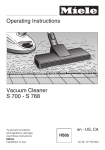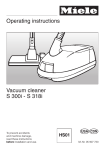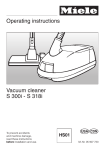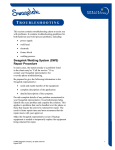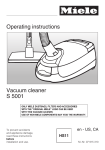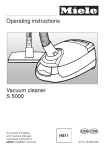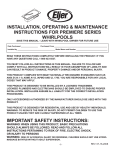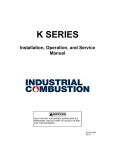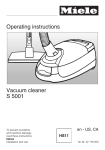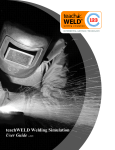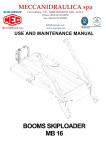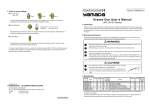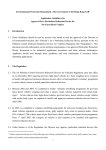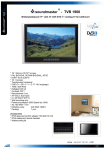Download Service Manual (ID180,ID290)
Transcript
Servicing Manual Date 09.06.2004 Revision Nr 00 Item Nr MOBILE (OIL- OR KEROSENE-FIRED) EMERGENCY AIR HEATERS MIRAGE - TORNADO SIAL S.p.A C.so Inghilterra, 15 - 12084 MONDOVI’ (CN) Tel. 0174 560611 fax. 0174 481086 Website www.sialspa.it e-mail: [email protected] Copyright No section of this document can be reproduced in any form or processed by means of electronic systems, copied or distributed without written permission by SIAL S.p.A. The translation into other languages is also allowed only under written permission by SIAL S.p.A. The use of this document is restricted to SIAL servicing centers and to distributors of SIAL products. This manual is not intended for end users. Technical changes SIAL S.p.A. has the right to modify any instruction, description and specification contained in this document without prior notice. 1 Servicing Manual FOREWORD Thank you for choosing the SIAL MIRAGE-TORNADO heaters. We would like to remind you that, as for any machine, you can get good operation and performance only if the heaters are correctly used and always kept in perfect efficiency. If required, the SIAL Technical Service can give you suggestions and assistance. The SIAL MIRAGE-TORNADO heaters are especially intended for the professional heating of civil, industrial and agricultural premises. Read and follow carefully the instructions contained in this manual before starting any servicing or maintenance operation. SIAL S.p.A. will not accept any responsibility for damages to persons, goods, properties or to the machine itself that may result from non-compliance with the instructions contained in this manual and with the Laws and safety rules in force in the Country of destination. 2 Servicing Manual INDEX OF CONTENTS 1 1.1 1.2 1.3 1.4 Operational diagrams and sequences Indirect-fired heaters with flue Direct-fired heaters without flue Heaters with and without flue: operational sequence Safety options in case of abnormal operation 2 2.1 2.2 2.3 2.4 2.5 Functional description of components Casing/Frame Motor/fan assembly Fuel circuit Burner head/Combustion chamber Electrical board 3 3.1 3.2 3.3 3.4 3.5 3.6 3.7 3.8 3.9 3.10 3.11 3.12 3.13 3.14 3.15 3.16 3.17 3.18 3.19 3.20 Troubleshooting guide - Operating flow-chart Checking the supply voltage Checking/replacing the power cord Checking/replacing the motor Checking/replacing the fan Exhaust gas analysis. Combustion air adjustment Cleaning the fuel tank Checking/cleaning/replacing the fuel filter Checking/cleaning/replacing the fuel nozzle Checking/cleaning/replacing the burner head and the whirl disc.. Cleaning the combustion chamber Replacing the motor/pump joint Checking/adjusting/replacing the fuel pump Checking and replacing the fuel solenoid valve Checking/cleaning/replacing the ignition electrodes Checking/replacing the high voltage cables Checking/replacing the ignition transformer Replacing the fuse Checking/cleaning/replacing the flame sensor Checking/replacing the overheat thermostat Checking operation of flame control unit 4.1 Setting chart - Indirect-fired heaters with flue Setting chart - Direct-fired heaters without flue Technical data sheets for indirect-fired heaters with flue Technical data sheets for direct-fired heaters without flue 4.2 Wiring diagrams - Basic version and versions with filter and nozzle fuel pre-heater 4.3 Special tools for servicing 3 Servicing Manual 1. OPERATIONAL DIAGRAMS AND SEQUENCES 1.1 INDIRECT-FIRED HEATERS WITH FLUE Flue Burner head Fuel pump Combustion chamber (closed) Motor Fuel tank 4 Fan Servicing Manual 1.2 DIRECT-FIRED HEATERS WITHOUT FLUE Burner head Fuel pump Combustion chamber (open) Motor Fuel tank 5 Fan Servicing Manual 1.3 HEATERS WITH AND WITHOUT FLUE: OPERATIONAL SEQUENCE T1 T2 T3 T4 T5 SW M T SV PH F Prepurge time Ignition time Operation time Safety time at flame failure Aftercooling time Switch Motor Ignition transformer Fuel solenoid valve Flame sensor Flame Prepurge sequence During the prepurge time (about 10 s) the fan blows air into the combustion chamber to expell any residual exhaust gases. The ignition transformer T produces a spark so that any small fuel residuals coming from the solenoid valve through the nozzle are completely burnt. At the same time the flame control unit checks for presence of flame or spurious light inside the combustion chamber: should this occur, the ignition sequence is interrupted and the heater locks out, that is all the electrical components are immediately unpowered. Ignition sequence During the ignition time, after the prepurge time, the fuel solenoid valve EV opens and the spark produced by the electrode ignites the fuel mist sprayed by the nozzle. The flame sensor (photoresistor) PH must feel the presence of flame within 1 s (safety time), otherwise the flame control unit locks out and the motor is stopped. If the flame sensor only feels a small flash and not a continuous flame, the whole prepurge and ignition sequence is repeated and then, if ignition is still unsuccessful, the unit goes to lockout and stops. 6 Servicing Manual Operational sequence 15 s after a regular flame ignition, the flame control unit de-energizes the ignition transformer and the electrodes stop sparking. The heater goes on operating with self-sustained combustion. The flame control unit monitors the regular presence of flame by means of the flame sensor. Any abnormal condition, such as lack of fuel, blockage of air inlet/outlet, dirty or clogged nozzle, that impairs regular combustion has the effect to close the fuel solenoid valve SV and to interrupt the fuel flow to the burner within the safety time. The flame control unit will then start a new complete prepurge/ignition sequence, and, should the problem repeat, the unit will lock out and the aftercooling sequence will start. Restart sequence If the flame shuts down for any reason, the flame control unit repeats the whole start sequence, consisting of the prepurge and the ignition sequences. If there is no flame signal within the safety time T4, the control unit goes to lock-out and the red lamp on the control panel lights up. If, on the contrary, a small flame signal is detected within the safety time, the control unit repeats the start sequence. The whole sequence will be repeated 3 times maximum and then the unit will definitely lock out. A maximum number of 3 ignition tries has been fixed to avoid that excessive smoke is produced during the repeated starting sequences. This effect could occur when the fuel tank is almost empty and the suction hose contains fuel and air mixed, or when the nozzle is partially blocked or damaged, and therefore the pressurized fuel is incorrectly sprayed. Aftercooling sequence During this time the heater is subjected to a cooling cycle to avoid excessive overheating of materials and components that could occur if the motor/fan suddenly stopped. This sequence is also very important from the point of view of efficiency, as all the residual heat that accumulates in the combustion chamber can be recovered and sent in the space to be heated. For safety reasons, it has been established that the high voltage ignition transformer must be energized during the aftercooling time. By doing this, any small fuel residuals coming from the solenoid valve SV will burn completely and will not accumulate inside the combustion chamber. Any explosion risk or abnormal heat release during future ignition sequences is therefore prevented. The aftercooling time is factory set and independent of the action of a limit control or similar devices on the combustion chamber. The aftercooling time lasts about 1 minute and 45 seconds. Lock-out sequence In the event of flame shut down due to lack of fuel or to another reason (see also the par. “SAFETY OPTIONS IN CASE OF ABNORMAL OPERATION”) the flame control unit will put the heater in a safety condition starting the lock-out sequence. During this sequence the fuel solenoid valve SV is immediately closed within the safety time T4 (< 1s) and then an aftercooling cycle will start to cool the surfaces of the combustion chamber. The ignition transformer is powered, and therefore a spark is produced by the electrodes, during the aftercooling cycle as described above. Reset sequence The unit can be reset by pushing the red reset pushbutton with integral warning lamp on the control panel. For safety reasons, reset will only be possible after about 30 s from lock-out. Also in the event of electrical supply failure/restoration, reset will only be possible after 30 s approximately. 7 Servicing Manual 1.4. SAFETY OPTIONS IN CASE OF ABNORMAL OPERATION • Spurious (external) light or anticipated ignition During the prepurge time no flame signal must come to the flame control unit. A flame signal with no flame could be due to external lights, short-circuit in the flame sensor or in the flame sensor leads, fault in the flame signal amplifier, fire on board of the unit, or, should the solenoid valve SV not properly interrupt the fuel flow to the nozzle, to anticipated ignition of the fuel/air mist during the prepurge time. In this case after the prepurge time and the safety time, the unit goes to lock-out. Special attention is required in the event that the heater is directly exposed to sunlight (e.g. when used outdoors). It may happen that sunrays come into the combustion chamber and give a false flame signal, especially when the heater is new and the inner surfaces are bright and reflect light. • Flame failure at ignition If there is no flame signal at the end of the safety time T4, the flame control unit goes to lock-out condition. • Flame failure during operation If the flame signal fails during operation, the flame control unit closes the fuel solenoid valve, the fuel flow to the nozzle is interrupted and a new prepurge/ignition cycle is started. In case of lock-out, the unit can be manually reset after 30 s approx. • Overheat thermostat activation In the event of combustion chamber overheating, the overhat thermostat interrupts the electrical supply to the flame control unit and to all components. The heater is immediately stopped. The possible causes of overheating are described in par. 3 “TROUBLESHOOTING GUIDE” 2. FUNCTIONAL DESCRIPTION OF COMPONENTS 2.1 CASING/FRAME Description The heater casing consists of : a tank made of galvanized steel which also acts as a support for the whole machine. a support fixed on the tank to which the lower half-shell of the heater is connected. This support also contains the electrical board. a lower half-shell which, together with the upper half-shell, forms the air duct where heat is transferred to the flowing air. All main components are directly fixed onto the lower shell. an upper half-shell that completes the air duct and can be disassembled by unscrewing 6 screws for servicing and maintenance. On the indirect-fired heaters with flue the upper shell includes a circular hole for the flue collar. on the upper shell you can also find an inspection door that allows operators to reach the components inside the heater and to carry out most of the repair and maintenance operations. on the rear, a protection guard is fitted on the air inlet to prevent any contact with the rotating parts of fan/motor. on the front, a half cylindrical protection shield if fitted between the combustion chamber and the lower shell, to limit the temperature of such part, that is directly accessible and can be touched by the operators. 8 Servicing Manual On the front a diffuser outlet cone allows the warm air (on indirect-fired heaters) or the mixture of warm air and exhaust gases (on direct fired heaters) to be released into the heated room. The axle with wheels and the support foot are connected below the tank. 2.2 FAN/MOTOR ASSEMBLY Description An electrical motor drives both the fan and the oil pump. A helicoidal fan provides a constant air flow in the axial direction, a part of which is used for the combustion ; the remaining part flows along the surfaces of the combustion chamber and of the heat exchanger, and it is consequently heated. The fan is connected to the motor shaft by means of a threaded pin. The oil pump has the function to suck fuel from the tank and to drive it to the nozzle at the rated pressure : the pump is connected to the motor shaft by a resin joint and fixed to the motor casing by means of 3 threaded pins. Single-phase, 2- or 4-poles motors with rotational speeds of 2800 rpm or 1400 rpm are used according to the heater model. See technical data sheet for detailed motor specifications. ILL. 1: particolare gruppo motore MIRAGE 85H – TORNADO 115 9 Servicing Manual 2.3 FUEL CIRCUIT Description The fuel circuit is basically composed of : tank suction and return hoses fuel filter, fuel pump, fuel solenoid valve, high pressure microhose combustion head nozzle The gear pump, driven by the motor, sucks fuel from the tank and increases its pressure to the rated value. At the pump outlet a fuel cut-out solenoid valve SV is fitted. The pump is controlled by the flame control unit. During normal operation the valve is open and the pressurized fuel flows to the nozzle, where it is atomized, mixed with primary combustion air and ignited by the electrode spark. The flow of primary air to the burner is adjusted by an air lock on the combustion head. Under abnormal operating conditions (see also flow-chart) the flame control unit closes the solenoid valve SV, fuel does not come to the nozzle but goes back to the tank through the return hose. An adjustment screw is fitted on the front of the pump ; it allows to adjust the pressure and consequently the fuel flow. ILL. 2: particolare gruppo filtro gasolio ILL. 3: particolare pompa gasolio 2.4 BURNER HEAD/COMBUSTION CHAMBER 10 Servicing Manual Description ILL. 4: particolare testa di combustione A certain amount of air coming from the fan flows around the combustion head, and, depending on the air lock setting, a part of it - the so-called primary air - flows inside the burner head. The primary air is distributed and mixed with the atomized fuel jet exiting the nozzle by means of a baffle disc. To get good combustion and therefore high efficiency, the adjustment of the primary air/fuel ratio must be very accurate. For this purpose, please carefully follow the setting specifications and instructions contained in this manual. The burner head includes : nozzle holder air lock baffle disc (whirl disc) fuel nozzle ignition electrode flame sensor (photoresistor) The fuel coming out of the nozzle is atomized and mixed with primary air. Additional circumferential openings on the burner head allow another amount of air, called secondary air, to flow into the chamber. That is an additional air delivery that completes combustion. During the whole ignition sequence the electrodes are powered by the high voltage transformer and produce a spark that ignites the fuel-air mixture. The function of the whirl disc is to induce a rotational component in the primary air flow and therefore to decelerate it : this way the mixing of fuel and air is increased and the combustion improved. The combustion chamber is made of stainless steel. It includes : a rear end on which the combustion head is fitted a front end with hole on direct heaters, without hole on indirect heaters a front flame shield on direct heaters the heat exchanger with gas passageways the exhaust gas flue collar the protection shield around the chamber a manually resettable overheat thermostat 2.5 ELECTRICAL BOARD 11 Servicing Manual Description ILL. 5: particolare cruscotto The electrical board has the function to broadcast the electrical supply coming from the electrical system through the power cord to all components, by means of a control/command electronic device, called burner (flame) control unit. This part has also the task to monitor flame and to ensure safe operation of the heater during all its operational sequences. The electrical board consists of the following parts : Control panel Protecting cover (against water/dust) Power cable with strain relief and plug ON/OFF switch Remote room thermostat socket with plastic cover and inner electrical bridge (closing circuit for operation without thermostat) Reset pushbutton with built-in warning lamp high voltage ignition transformer fuse with fuseholder electronic burner (flame) control unit 3. TROUBLESHOOTING 12 Servicing Manual SWITCH ON Check for correct voltage rating ( see data plate) Check that the green warning lamp on the control panel is alight Check fuse (burn-outs, damages, etc.) • Check all electrical connections • Check the warning lamp • Replace with a new one with identical ratings THE HEATER STARTS no • • See chapter 3... Replace the burner control unit • Wait 30 seconds and push to reset • Open the inspection cover and push to reset Check that the remote thermostat is properly connected and adjusted • • Check connections Set a temperature value higher than room temperature For operation without remote thermostat, check that the thermostat socket cover is correctly inserted in the socket • Check the metal bridge inside the cover Reinsert and lock Check the burner control unit yes Check that the red lock-out warning light is not alight Check that the overheat thermostat has not been activated 13 • Servicing Manual Check that the oil tank is full • • Tighten the oil line fittings Check for damages/cracks in the oil hoses Check that the nozzle is clean • See chapter “Cleaning the combustion head” Check that the whirl disc is clean • See chapter “Cleaning the combustion head” • • Clean the flame sensor with a soft cloth and ethylic alcohol Replace the flame sensor if damaged or burnt Check the adjustment of air lock • See technical data sheets section Check for presence of external (spurious) lights (sunlight, lamps) • Look for - and eliminate - light reflections due to sunrays, lamps etc. that could reach and disturb the flame sensor Look for fires inside the machine Check for air bubbles in the oil filter THE HEATER STARTS, THE PREPURGE SEQUENCE STARTS BUT THEN THE HEATER STOPS WITHOUT IGNITION yes no Ckeck that the flame sensor is not damaged, clean and properly fixed in its seat • 14 Servicing Manual Check the nozzle size THE HEATER STARTS, FLAME IGNITES BUT COMBUSTION IS NOT GOOD yes • Look for the correct nozzle size on the setting chart. • Replace if necessary Check the air lock adjustment • See setting chart Check that the nozzle is clean • • See chapter 3.8 Replace the nozzle Check that the fuel filter is clean • See chapter 3.7 • See chapter 3.12 no Check that the pump filter is clean Check that there are no air bubbles in the fuel line • • Tighten fittings Replace faulty pipes/hoses Incorrect fuel pressure • • Measure and adjust the pressure Replace the pump (see chapter 3.12) • Empty the tank and refill with clean fuel of correct type Fuel is of incorrect type, dirty, polluted or contains water 15 Servicing Manual Overheat thermostat incorrectly activated • • Wrong location of overheat thermostat (after incorrect servicing, repairs etc.) Wrong thermostat setting (use of an incorrect type) THE HEATER SUDDENLY STOPS yes S no Excessive overheating of combustion chamber (overheat thermostat correctly activated) • • • • OK • • • 16 Wrong (too large) nozzle size (see specification chart) Wrong (too high) fuel pressure (see specification chart) Insufficient ventilation due to motor fault Insufficient ventilation due to fan failure Blockage of airways due to dirt or foreign objects Exhaust pipe partially obstructed Combustion chamber clogged by soot. (see chapter.3.10) Servicing Manual THE MAINTENANCE OPERATIONS DESCRIBED IN THIS MANUAL MUST BE CARRIED OUT BY QUALIFIED PERSONNEL ONLY, IN COMPLIANCE WITH THE ELECTRICAL SAFETY STANDARDS IN FORCE. ONLY USE ORIGINAL OR RECOMMENDED SPARE PARTS. 3.1 CHECKING THE SUPPLY VOLTAGE The supply voltage must match with the rated voltage indicated on the data plate. The actual input voltage must be within -15% and + 10% of the rated voltage for good and safe operation. • Measure the mains voltage, inserting the multimeter tips into the electrical socket and compare it with the rated voltage written on the data plate. If no voltage is found : • Check the electrical system fuse(s) and the main distribution board. • Check the electrical socket. Ill. 6 • Unscrew the fixing screw of the resin board cover and remove the cover. Note : Only carry out maintenance/repairs on the heater and not on the electrical system, for which servicing by authorized personnel is required. 3.2 CHECKING AND REPLACING THE POWER CORD . • Check that the green warning lamp lights up. If it does not, this means the heater is not powered. • Check the conditions of cable and plug and look for damages and failures. • Unscrew the fixing screws of the control panel and extract the electrical board. Ill. 7 • Check voltage between mains terminals (live and neutral) on the cable strain relief. If no voltage is found, check the fuse. If it is damaged or burnt, replace it with one with same current ratings (“slow-blow” type) Ill. 8 17 Servicing Manual To replace the power cord • Only use H07RN-F power cords (Europe) or SJT power cords (USA) with watersplashproof plug. • Disconnect the line leads and earth leads from terminals Ill. 10 • • • • Check the capacitor. To replace the motor: Unpower the machine by unplugging it. Disconnect the motor leads on the burner control unit (see picture #10). • Remove the upper shell by unscrewing its 6 fixing screws. Ill. 9 • Remove the defective cable. • Insert the replacement cable into the strain relief (inner lenght : about 5 cm). • Fix the strain relief into its seat. • Connect the line and earth leads to terminals. • Check for proper operation. • Reassemble the electrical panel. 3.3 CHECKING AND REPLACING THE MOTOR • Extract the electrical board (see picture) • Check voltage at the motor terminals using a multimeter. Ill. 11 • Disassemble the fan. (see chapter 3.4) • Loosen the fuel pump fixing screws and disconnect the pump (see chapter 3.12). • Unscrew the fixing screws of the motor bracket on the lower support. 18 Servicing Manual Viti fissaggio motore Ill. 12 Ill. 14 • Unscrew the fixing screws of the motor on the bracket. • Replace the capacitor with one with same capacity (µF rating). • Connect, check operation and reassemble. 3.4 CHECKING AND REPLACING THE FAN WARNING : MAKE SURE THAT THE HEATER IS NOT POWERED BEFORE OPERATING ON MOVING PARTS WITHOUT GUARDS IN PLACE. BODY INJURY DANGER! • Remove the rear guard and look for possible damages or obstructions not allowing the fan to rotate. To replace a damaged fan: • Unscrew the fixing screw on the fan hub. Ill. 13 • Replace motor and fix it on the bracket. Connect bracket to lower support. Connect motor leads on the terminal board following the wiring diagram. • Check operation. • Reassemble fan, fuel pump, rear guard, upper shell and electrical board. To replace the capacitor : • Remove the inspection cover. • Extract the capacitor from its support. • Disconnect leads on the capacitor. Ill. 15 19 Servicing Manual • Insert the pump end into the flue extension. • Extract the damaged fan and replace it. • Check by hand that the fan can rotate freely without interference. • Check operation after reassembling guards. 3.5 EXHAUST GAS ANALYSIS (for heater with flue only). COMBUSTION AIR ADJUSTMENT Perform an exhaust gas analysis with the ShellBacharach method to check the quality of combustion. • Use a standard smokemeter (Shell-Bacharach pump) . Ill. 18 • With the heater operating in normal conditions, draw in the exhaust gases for 10 times (IMPORTANT : 10 TIMES EXACTLY), taking care to carry out all movements slowly and using the complete piston stroke. • Extract the paper strip, check the colour and compare it with the reference scale to assign a smoke number. Ill. 16 • Insert a test strip into the pump slot . Ill. 19 Oil-fired heaters are factory set by the manufacturer to give a smoke number equal to 0 (zero) of the Shell-Bacharach scale. A smoke number greater than 1 indicates bad combustion. Should this occur, the causes of the problem should be detected and eliminated. Ill. 17 • Connect an extension for exhaust gas analysis to the flue adapter. 20 Servicing Manual The most important factors that can cause high smoke numbers are : Clogged combustion chamber due to incorrect installation (exhaust flue obstructed or badly designed, see chapter 3.10 and user instruction manual) Operation without flue adapter Dirty combustion head, fuel lines and/or nozzle (see chapter 3.9) “Too closed” adjustment of air lock (see chapter 3.9. Ill. 21 3.6 CLEANING THE FUEL TANK To clean the fuel tank: • Lift the heater at about 1 m height using a fork truck or other suitable means. • Place a proper container under the heater tank. • Unscrew the drainage cap on the tank bottom to discharge the fuel completely. Ill. 20 Lack of combustion air due to installation too close to a wall or in a small room without openings towards outside. AIR LOCK ADJUSTMENT • Remove the inspection cover. • Unscrew the fin screw on the combustion head. • Move the air lock in the axial direction to reach the position shown on the setting chart supplied by the manufacturer (see setting chart at the end of this manual) Ill. 22 To clean the fuel filler filter, extract the filter from the tank filler cap, clean it and reassemble. 21 Servicing Manual • Clean the filter cartridge using a soft brush and then blow compressed air. To replace the complete filter: • Loosen the filter fittings and unscrew the filter/bracket fixing nut . • Reassemble and connect fuel hoses. 3.8 CHECKING/CLEANING/ REPLACING THE OIL FILTER • Remove the inspection panel. • Remove the fixing screw on the burner head (nozzle-holder) Ill. 23 3.7 CHECKING/CLEANING/REPLACING THE OIL FILTER Ill. 26 Ill. 24 • Unscrew the lower filter body (glass). • Pour out the fuel contained in the filter. • Open the filter and extract the filter cartridge. • Extract the nozzle holder by rotating it clockwise to release it from the fixing hooks. Ill. 25 Ill. 27 22 Servicing Manual • Remove the inspection cover. • Loosen (do not unscrew completely) the fixing screws of the end disc on the combustion head. Ill. 28 • Unscrew the nozzle taking care not to touch the electrode, as impacts could damage the electrode ceramic insulators and impair good ignition. Ill. 30 • Slightly rotate the combustion head clockwise so that the screw heads match with the big holes on end disc. This will be helpful when reassembling, as the screws will act as supporting and centering means for the combustion head. Ill. 29 • Clean the nozzle blowing compressed air inside it. • If cleaning is not sufficient, replace the nozzle. Only use the nozzle sizes and types recommended by the manufacturer (see setting chart). • Reassemble the nozzle. • Reassemble the burner head and the inspection cover. Ill. 31 • Extract the combustion head. 3.9 CHECKING/CLEANING/REPLACING THE BURNER HEAD AND THE WHIRL DISC. 23 Servicing Manual Ill. 32 Ill. 34 • Clean the whirl disc using a brush and then blow compressed air on it. To get good combustion the air flow openings in the whirl disc should be perfectly clean and free. • Extract the combustion chamber and if required clean using Diesel oil • Eliminate any Diesel residuals, carefully dry and reassemble the combustion head, the burner head and the upper shell. 3.11 REPLACING JOINT THE MOTOR/PUMP • Loosen (do not unscrew completely) the 3 fixing screws on the fuel pump Ill. 33 3.10 CLEANING CHAMBER THE COMBUSTION • Remove the upper shell. • Disassemble the burner head (see chapter 3.8). • Disassemble the combustion head (see chapter 3.9). • Unscrew the fixing screws on the combustion head. Ill. 35 • Extract the pump sliding it in the axial direction. 24 Servicing Manual • Close the inspection panel and start a short ignition cycle (10 s prepurge followed by 3 s first ignition) • Shut down the heater turning the ON/OFF switch to 0 so that the aftercooling cycle starts and the motor continues to rotate. • Open the inspection cover and turn the screw on the pump head clock- ot anticlockwise (reading at the same time the pressure gauge) until the correct pressure setting is reached. Ill. 36 • Check the conditions of the coupling and replace it if required. • Make sure that the motor shaft can rotate freely (move the fan by hand to check) • Reassemble. 3.12 CHECKING/CLEANING/ADJUSTING /REPLACING THE FUEL PUMP Ill. 38 • Remove the inspection cover. To measure the delivery pressure: • Unscrew the screw on the upper part of the pump To measure the suction vacuum: • Unscrew the screw marked with “V”. • Connect a vacuum-meter to the port “V”. To clean the pump filter: • Unscrew the filter fixing screw on the pump carter and extract the filter. Ill. 37 • Connect a pressure gauge with a suitable measuring range. Ill. 39 25 Servicing Manual Ill. 41 • Clean the filter with compressed air or wash it with clean Diesel oil. • Reassemble • Extract the inner cylinder and clean it with Diesel oil. To replace the pump: • Loosen the pump fixing screws. • Make sure that the motor/pump resin joint is correctly fitted. • Replace the pump and reassemble the whole unit 3.13 CHECKING AND REPLACING THE FUEL SOLENOID VALVE • Unscrew the solenoid valve fixing nut. Ill. 42 Check that the inner cylinder can slide freely. If required clean the piston. To replace the solenoid valve: • Open the electrical board. • Check voltage at the solenoid valve terminals. Ill. 40 • Extract the valve casing. • Unscrew the fixing nut of the inner cylinder. Ill. 43 If a voltage can be measured on the terminals shown in the picture but the solenoid valve does not work : • Disconnect the valve leads from the burner control unit. • Replace the solenoid valve. • Reconnect and check operation. 26 Servicing Manual • Disconnect the solenoid fuel valve from mains. • Give power to the heater and allow a start cycle to take place turning the ON/OFF switch to I (ON). • Visually check that the ignition electrodes produce a regular spark . Warning At ignition, an 11 kW high voltage is produced between the electrode tips. Carefully follow the electrical safety regulations during all servicing and maintenance operations. • Reconnect the solenoid valve leads after checking spark. 3.14 CHECKING/CLEANING/ADJUSTING/ REPLACING ELECTRODES • Extract the burner head. To replace the electrodes: • Disconnect the high voltage leads from electrodes. • Unscrew the electrode fixing screws. Ill. 44 • Check that the electrode tips are clean. • If not, clean them with a soft brush and then with compressed air. • Check the clearances between electrode tips and between electrode tips and nozzle. • Adjust the clearances according to the diagram below : Ill. 45 • Replace the electrodes and reconnect the high voltage leads. • Reassemble the burner head. 3.15 CHECKING AND REPLACING HIGH VOLTAGE CABLES • Check that the high voltage cables are properly connected. • Check the conditions of high voltage cables and look for possible damages. Disconnect the high voltage cables from electrodes and from the ignition transformer in the electrical board. To check that ignition spark is regular: • Insert the nozzle holder into the burner head and fix it wih a proper screw. • Completely open the air lock. 27 Servicing Manual 3.17 REPLACING THE FUSE • Open the electrical board. • Extract the fuse from the fuse holder in the electrical board. Ill. 46 • Connect the new cables and check operation. 3.16 CHECKING/REPLACING IGNITION TRANSFORMER THE Ill. 48 To replace the transformer: • Unscrew the transformer fixing screw and nut on the electrical board. • Disconnect the high voltage cables from the transformer. • Disconnect the high voltage cables from the burner control unit. HT transformer line • Check the conditions of fuse. • Replace the faulty fuse with one with identical current ratings. See technical specifications. 3.18 CHECKING, CLEANING REPLACING THE FLAME SENSOR HT transformer neutral AND • Extract the flame sensor from its seat in the burner head disc, by turning it about ¼ turn to loosen the fixing feet of flame sensor support. Ill. 47 • Replace the transformer, reconnect cables to transformer and burner control unit following the wiring diagram shown on the label placed on the electrical board cover. Ill. 49 28 Servicing Manual • Replace the faulty sensor. • Reconnect, reassmble and check operation. • Gently push the sensor leads to extract the flame sensor. Clean the sensor glass with a cloth soaked with ethylic alcohol to eliminate any soot or dust residuals. 3.19 CHECKING/REPLACING OVERHEAT THERMOSTAT THE • Remove the inspection cover and/or the upper shell. • Check that the thermostat is properly fixed and connected. To replace the thermostat: • Disconnect the thermostat cables. • Replace the thermostat. • Reconnect and reassemble. To reset the overheat thermostat: • Unplug the heater • Remove the inspection door • Push the reset button Ill. 50 It is possible to check the proper operation of the flame sensor simply using a multimeter. Connect the multimeter terminals to the sensor leads and proceed as follows: • Set the multimeter to measure resistance • Expose the flame sensor to light. • Under normal conditions, the tester should show ohmic resistance quickly decreasing as illumination increases. To replace the flame sensor: • Disconnect the flame sensor leads from the burner control unit (see wiring diagram ). Ill. 52 3.20 CHECKING OPERATION BURNER (FLAME) CONTROL UNIT OF Perform the following tests to check operation of the burner control unit. Check reset pushbutton/ lock-out warning lamp Ensure that the lock-out warning lamp is correctly connected (see diagram) Ill. 51 29 Servicing Manual M1 M2 M19 Ill. 53 Check that there is electrical continuity between the terminals 1 and 3 of the reset pushbutton. Check that there is a 18-20V voltage between the terminals M2 and M19 of the burner control unit when the unit is in lock out condition (the lamp is alight). Check voltage on the transformer, motor and solenoid valve terminals and that they are correctly energized according to the operational cycle. Electrical continuity check Unplug the heater Turn switch to I (ON) Set the room thermostat in a operating (closed) position Check that the overheat thermostat is closed Check electrical continuity between terminals M3 and M4 of the electronic control unit (with all wires connected). Ill. 54 Power supply to loads Plug the heater. Turn switch to I (ON) Set the room thermostat in a operating (closed) position Using a multimeter, check that the burner control unit is powered The voltage supply to components must match with the mains voltage. Should this not occur, or should the components not be correctly energized according to the operational cycle, replace the flame control unit with a new one. Lock-out test Start the heater and wait that the ignition cycle is completed. (wait until the ignition spark stops). Disconnect the flame sensor fast-on from terminal M5 on the burner control unit. The heater must immediately lock-out. The red warning lamp must light up. 30 Servicing Manual Reset must be possible only after at least 30 seconds. 31 Servicing Manual 4.1 SETTING CHART - INDIRECT-FIRED HEATERS (WITH FLUE) CHAMBER INLET FAN MIRAGE 37 H USA # 8 holes 6 mm dia. dia.=350mm 3 blades 18° MIRAGE 55 H USA # 8 holes 6 mm dia. MIRAGE 85 H USA # 8 holes 10 mm dia. WHIRL (BAFFLE) DISC FUEL PUMP FUEL PRESSURE BURNER NOZZLE AIR LOCK OPENING OVERHEAT THERMOSTAT out. dia.=76mm DANFOSS in. dia.=27mm R3 10 blades 12 bar DANFOSS 0.65 60°H 3 mm 170 °C lock position 1 (red markings) dia.=350mm 3 blades 18° out. dia.=76mm DANFOSS in. dia.=27mm R3 10 blades 12 bar 7 mm 170 °C lock position 2 (red markings) dia.=500mm 4 blades 33° out. dia.=76mm DANFOSS in. dia.=22mm R5 10 blades 12 bar 14 mm 170 °C lock position 3.5 - 4 (red markings) 32 DANFOSS 1.00 60°H DELAVAN 1.50 80°W Servicing Manual SETTING CHART - DIRECT-FIRED HEATERS (WITHOUT FLUE) CHAMBER INLET FAN WHIRL (BAFFLE) DISC FUEL PUMP FUEL PRESSURE BURNER NOZZLE AIR LOCK OPENING OVERHEAT THERMOSTAT TORNADO 67 USA # 8 holes dia. 6 mm dia.=350mm 3 blades 18° out. dia.=76mm in. dia.=27mm 10 blades DANFOSS R3 12 bar DANFOSS 1.25 60°H 4 mm 100 °C lock position 1.5 (black markings) TORNADO 115 # 8 holes dia. 10 mm dia.=500mm 4 blades 33° out. dia.=76mm in. dia.=27mm 10 blades DANFOSS R5 13 mm 100 °C lock position 3.5 (black markings) 33 12 bar DELAVAN 2.25 80°W Servicing Manual TECHNICAL DATA SHEET FOR INDIRECT FIRED OIL HEATERS – 37 kW MODEL Thermal Specifications Airflow Specifications Maximum Thermal Power (Diesel Oil) Consumption Kg/hr at 3°C (37F) U.S. gal/hr Efficiency % Power Input kcal/hr kW BTU/hr Power Output kcal/h kW BTU/hr Fuel Pressure 12 bar Smoke Index Air Lock Adjustment mm Maximum Thermal Power (Kerosene) Consumption Efficiency Power Input Power Output Fuel Pressure psi Air Lock Adjustment mm Kg/hr % kcal/hr kW BTU/hr kcal/hr kW BTU/hr 2,88 0,90 87,10 31304 36,40 125216 27266 31,70 109063 Air Flow Rating m³/h 2000 m³/h Fan Diameter mm Blade # Pitch 350 mm 14 in 3 sickle-shaped 18° 1180 ft³/min Rated Voltage V/Hz 110/60 Rated Current A 7,0 Rated Power W 460 Motor Power W 430 Temperature Rise (Delta) at 20°C (68 F) 175 psi Noise Level dB(A) average with original hood 1,00 Nozzle Type 3,0 Manufacturer Type Flow Rate 2,64 87,10 Air Ducting 29106 Hose Diameter 33,84 116425 Maximum Hose Lenght 25352 29,48 101406 12,00 Electrical Specifications 54°C at 1 m 77 GPH 97 F at 2 m 75 DANFOSS 60° H 0,65 315 mm 12 in 8m 25 ft *oil gross heating value Kcal/kg 34 10869,44 *kerosene gross heating value Kcal/kg 11.025,08 3,00 according to standard prEN 13842:2002 Rotational Speed rpm Fuse A Size Specifications Weight 70 kg 154 lb Lenght 1188 mm 47 in Width 620 mm 24 in Height 790 mm 31 in 3400 15 slow-blow Tank Capacity 51 liters 14 U.S. gal Outlet Diameter 308 mm 12 in Flue Diameter 150 mm 6 in Package Specifications 1250 mm Height Lenght 530 mm Weight Width 830 mm 72 Kg Servicing Manual TECHNICAL DATA SHEET FOR INDIRECT FIRED OIL HEATERS – 55 kW MODEL Thermal Specifications Airflow Specifications Maximum Thermal Power (Diesel Oil) Consumption Kg/hr at 3°C (37F) U.S. gal/hr Efficiency % Power Input kcal/hr kW BTU/hr Power Output kcal/h kW BTU/hr Fuel Pressure 12 bar Smoke Index Air Lock Adjustment mm Maximum Thermal Power (Kerosene) Consumption Efficiency Power Input Power Output Fuel Pressure psi Air Lock Adjustment mm Kg/hr % kcal/hr kW BTU/hr kcal/hr kW BTU/hr 4,16 1,29 87,10 45217 52,58 180868 39384 45,80 157536 Air Flow Rating m³/h Fan mm Blade # Pitch 2500 m³/h 1475 ft³/min 350 mm 14 in 3 sickle-shaped 18° Rated Voltage V/Hz 110/60 Rated Current A 7,0 Rated Power W 460 Motor Power W 430 Temperature Rise (Delta) at 20°C (68 F) 175 psi Noise Level dB(A) average with original hood 1,00 Nozzle Type 4,0 Manufacturer Type Flow Rate 3,81 87,10 Air Ducting 42006 Hose Diameter 48,84 168022 Maximum Hose Lenght 36587 42,54 146347 12,00 Electrical Specifications 73°C 131 F at 1 m 75 at 2 m 73 GPH DANFOSS 60° H 1,00 315 mm 12 in 8m 25 ft *oil gross heating value Kcal/kg 10869,44 *kerosene gross heating value 35 Kcal/kg 11.025,08 7,00 according to standard prEN 13842:2002 Rotational Speed rpm Fuse A Size Specifications Weight 76 kg 167 lb Lenght 1405 mm 55 in Width 620 mm 24 in Height 790 mm 31 in 3400 15 slow-blow Tank Capacity 51 liters 14 U.S. gal Outlet Diameter 308 mm 12 in Flue Diameter 150 mm 6 in Package Specifications 1470 mm Height Lenght 530 mm Weight Width 830 mm 80 Kg Servicing Manual TECHNICAL DATA SHEET FOR INDIRECT FIRED OIL HEATERS – 85 kW MODEL Thermal Specifications Airflow Specifications Maximum Thermal Power (Diesel Oil) Consumption Kg/hr at 3°C (37F) U.S. gal/hr Efficiency % Power Input kcal/hr kW BTU/hr Power Output kcal/hr kW BTU/hr Fuel Pressure 12 bar Smoke Index Air Lock Adjustment mm Maximum Thermal Power (Kerosene) Consumption Efficiency Power Input Power Output Fuel Pressure psi Air Lock Adjustment mm Kg/hr % kcal/hr kW BTU/hr kcal/hr kW BTU/hr 6,64 2,06 88,50 72173 83,92 288692 63873 74,27 255493 Air Flow Rating m³/h Fan Diameter Blade # Pitch 4500 m³/h 2650 ft³/min 500 mm 20 in 3 sickle-shaped 28° Rated Voltage V/Hz 110/60 Rated Current A 12,0 Rated Power W 800 Motor Power W 750 Temperature Rise (Delta) at 20°C (68 F) 175 psi Noise Level dB(A) average with original hood 1,00 Nozzle Type 14,0 Manufacturer Type Flow Rate 4,86 88,50 Air Ducting 53582 Hose Diameter 62,30 214328 Maximum Hose Lenght 47420 55,14 189680 12,00 Electrical Specifications 72°C 130 F at 1 m 73 at 2 m 71 GPH DELAVAN 80° W 1,50 450 mm 18 in 16 m 52 ft *oil gross heating value Kcal/kg 10869,44 *kerosene gross heating value 36 Kcal/kg 11.025,08 14,00 according to standard prEN 13842:2002 Rotational Speed rpm Fuse A Size Specifications Weight 121 kg 267 lb Lenght 1680 mm 66 in Width 690 mm 27 in Height 938 mm 37 in 1700 20 slow-blow Tank Capacity 100 liters 26 U.S. gal Outlet Diameter 443 mm 17 in Flue Diameter 150 mm 6 in Package Specifications 1760 mm Height Lenght 650 mm Weight Width 965 mm 124 Kg Servicing Manual TECHNICAL DATA SHEET FOR DIRECT FIRED OIL HEATERS – 67 kW MODEL Thermal Specifications Airflow Specifications Maximum Thermal Power (Diesel Oil) Air Flow Rating Consumption Kg/hr at 3°C (37F) 5,22 2800m³/h U.S. gal/hr 1,62 Efficiency % Fan Power Input kcal/hr 56739 Diameter 350 mm kW 65,98 Blade # 3 sickle-shaped 18° BTU/hr 226954 Pitch Power Output kcal/hr kW Temperature Rise (Delta) BTU/hr at 20°C (68 F) Fuel Pressure 12 bar 175 psi Noise Level at 1 m dB(A) average 75 Smoke Index 1,00 Air Lock Adjustment Nozzle Type mm 4,0 Manufacturer Type Maximum Thermal Power (Kerosene) Flow Rate GPH Consumption Kg/hr Efficiency % Air Ducting Power Input kcal/hr 0,00 Hose Diameter kW 0,00 BTU/hr 0,00 Maximum Hose Lenght Power Output kcal/hr 0,00 kW 0,00 BTU/hr 0,00 Fuel Pressure psi 0,00 *oil gross heating value Kcal/kg Air Lock Adjustment *kerosene gross heating value Kcal/kg 37 mm 0,00 according to standard prEN 13842:2002 Electrical Specifications 1650 ft³/min Rated Voltage V/Hz 110/60 14 in Rated Current A 6,0 Rated Power W 460 Motor Power W 430 at 2 m 73 Rotational Speed rpm Fuse DELAVAN A 60° S 1,25 Size Specifications Weight 65 kg 143 lb Lenght 1405 mm 55 in Width 620 mm 24 in Height 750 mm 30 in 10869,44 11.025,08 3400 10 slow-blow Tank Capacity 51 liters 14 U.S. gal Outlet Diameter 308 mm 12 in Flue Diameter Package Specifications 1470 mm Height Lenght 530 mm Weight Width 830 mm 76 kg Servicing Manual TECHNICAL DATA SHEET FOR INDIRECT FIRED OIL HEATERS – 115 kW MODEL Thermal Specifications Airflow Specifications Maximum Thermal Power (Diesel Oil) Consumption Kg/hr at 3°C (37F) 9,12 U.S. gal/hr 2,83 Efficiency % Power Input kcal/hr 99129 kW 115,27 BTU/hr 396517 Power Output kcal/h 0 kW 0,00 BTU/hr 0 Fuel Pressure 12 bar 175 psi Air Flow Rating m³/h 4800 m³/h Fan mm Blade # Pitch 500 mm 14 in 3 sickle-shaped 28° Electrical Specifications 2850 ft³/min Rated Voltage V/Hz 110/60 Rated Current A 12,0 Rated Power W 800 Motor Power W 750 Temperature Rise (Delta) at 20°C (68 F) Noise Level dB(A) average at 1 m 75 at 2 m 73 Smoke Index Rotational Speed rpm 1760 1,00 Air Lock Adjustment mm Maximum Thermal Power (Kerosene) Consumption Kg/hr Efficiency % Power Input kcal/hr kW BTU/hr Power Output kcal/hr kW BTU/hr Fuel Pressure psi Air Lock Adjustment mm Nozzle Type 13,0 Manufacturer Type Flow Rate GPH DANFOSS 80° W 2,25 Air Ducting 0,00 Hose Diameter 0,00 0,00 Maximum Hose Lenght 0,00 0,00 0,00 0,00 *oil gross heating value Kcal/kg 10869,44 *kerosene gross heating value 38 Kcal/kg 11.025,08 0,00 according to standard prEN 13842:2002 Fuse A Size Specifications Weight 101 kg 222 lb Lenght 1680 mm 66 in Width 690 mm 25 in Height 898 mm 35 in 20 slow-blow Tank Capacity 100 liters 14 U.S. gal Outlet Diameter 308 mm 12 in Flue Diameter 150 mm 6 in Package Specifications 1760 mm Height Lenght 650 mm Weight Width 965 mm 116 Kg Servicing Manual 4.2 WIRING DIAGRAM Basic version 39 EV Fuel solenoid valve TR High voltage transformer M Motor SL Warning lamp TS Overheat thermostat FS Fuse FC Flame sensor PL Reset pushbutton IN Switch TH Remote (room) thermostat FR Heated filter (optional) Servicing Manual Version with heated filter and nozzle pre-heater 40 EV Fuel solenoid valve TR High voltage transformer M Motor SL Warning lamp TS Overheat thermostat FS Fuse FC Flame sensor PL Reset pushbutton IN Switch TH Remote (room) thermostat FR Heated filter (optional) Servicing Manual 4.3 SPECIAL SERVICING TOOLS 1. 2. 3. 4. 5. Smokemeter Strips for smokemeter Shell-Bacharach reference scale Pressure gauge for oil pressure measurement Electrical multimeter 5 3 2 4 1 Ill. 55 Ill. 56 41









































